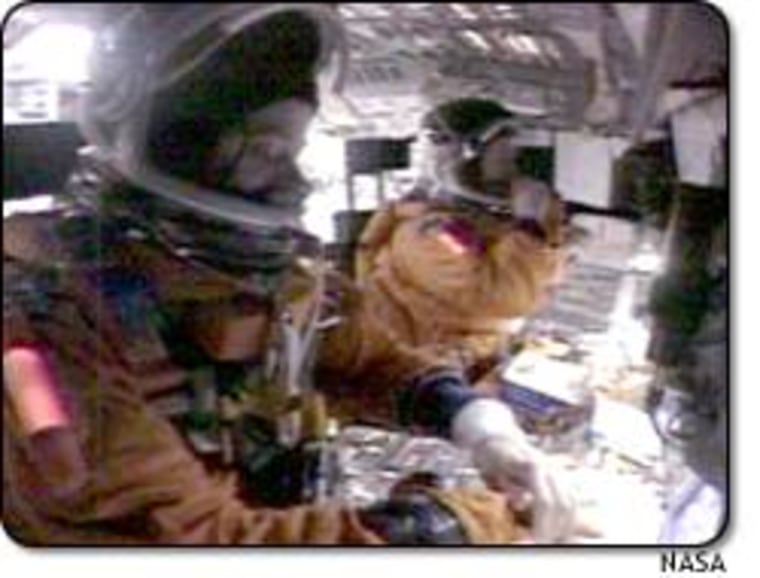In the last half-hour of their lives, the space shuttle Columbia’s astronauts happily went through the routines for their homecoming — sipping at drinks, marveling at the “blast furnace” outside their window, and mugging for the camera that recorded those last moments.
The scenes from Columbia’s re-entry on Feb. 1 were preserved on a cockpit video discovered Feb. 6 near Palestine in East Texas, and first aired publicly by NASA on Feb. 28. Among the more than 250 videos aboard Columbia — most of them to document scientific experiments — it was the only one recovered that had any recording left.
The 13-minute video, shot with a hand-held digital camera, shows flight-deck activity beginning around 8:35 a.m. ET as Columbia soared 500,000 feet (150 kilometers) above the south-central Pacific Ocean. It continues until 8:48 a.m., when the shuttle was over the eastern Pacific, southwest of San Francisco, at an altitude of about 250,000 feet (75 kilometers).
Commander Rick Husband, pilot William McCool, astronaut Laurel Clark and Indian-American astronaut Kalpana Chawla can be seen in the cockpit. The other three astronauts — Michael Anderson, David Brown and Israel’s Ilan Ramon — are out of view on the shuttle’s middeck.
The images show nothing that hints at the cause of Columbia’s breakup. The tape ends four minutes before any sign of trouble and seven minutes before the loss of contact with Mission Control.
The shuttle broke up over Texas at an altitude of 207,000 feet (63 kilometers), traveling at about 18 times the speed of sound, or 12,500 mph.
No sign of fear
Investigators believe that Columbia may have come apart after hot plasma, generated by the shock wave of the shuttle’s re-entry through the atmosphere, flashed through a breach in the left wing. On the tape, however, the astronauts consider the plasma something to be wondered at rather than feared.
“It’s really neat. It’s a bright orange-yellow out over the nose, all around the nose,” McCool says.
“Wait till you start seeing the swirl patterns out your left or right windows,” Husband responds.
“Wow,” McCool says.
“Looks like a blast furnace,” Husband says. Then later he adds, “Yeah, you definitely don’t want to be outside now.”
“What, like we did before?” Clark jokes.
The astronauts collect empty drink bags and put on their spacesuit gloves. The camera is mounted at first, then Clark grabs it. She trains it on Chawla, who waves. Then Clark turns it around, framing her own face, and grins broadly.
NASA showed the video to the families of the crew before airing it publicly. Experts on trauma treatment said the images most likely offered some peace of mind, since it showed the astronauts happy and doing what they loved.
“Some might view it as a miracle,” said Charles Figley, director of the Traumatology Institute at Florida State University. “Suddenly here is a post card of these men and women.”
The Associated Press contributed to this report.
